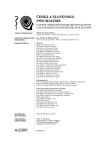Parasitic Delusion in Psychiatric Outpatient Department
Authors:
M. Zvěřová
Authors‘ workplace:
Psychiatrická ambulance Fakultní polikliniky VFN, Praha
přednosta prof. MUDr. J. Raboch, DrSc.
Published in:
Čes. a slov. Psychiat., 105, 2009, No. 4, pp. 177-180.
Category:
Case Report
Overview
Parasitic delusion becomes manifest as an irrefutable belief of being attacked by insects. It often causes unbearable itching results in the individual’s defense with superfluous and unsuitable application of cleaning and disinfection remedies which often cause skin damage. The patients usually seek heal in a dermatologist who subsequently refers them to the psychiatric care. The dilemma in classification of the psychopathological picture occurs from the time of the first description of the disease more than a hundred years ago. According to the International Classification of Diseases-10 may possible be diagnosed as a permanent disorder with dilutions (F22.0). Antipsychotics and antidepressants offer effective therapy as also documented by two cases of the author.
Key words:
parasitic delusion, tactile hallucinosis, acrophobia, folie a deux, difficult classification, treatment with antipsychotics and antidepressants.
Sources
1. Anjeli, K., Koo, J.: Psyche, opioids, and itch: therapeutic consequences. Dermatologic Therapy, 18, 2005, pp. 314-322.
2. Bers, N., Conrad, K.: Die chronische taktile Halluzinose. Fortschr. Neur., 22, 1954, pp. 254-270.
3. Bhatija, M. S. et al.: Delusional parasitosis: a clinical profile. Int.´l J. Psychiat. in Medicíně, 30, 2000, pp. 83-91.
4. Conrad, K.: Zum Problem der chronischen taktilen Halluzinose. Arch. Psychiat. Neurol., 193, 1955, pp. 601-606.
5. Daniel, E. et al.: Folie a famille: Delusional parasitosis affecting all the members of a family. Indian J. Dermatol. Venerol. Leprol., 70, 2004, pp. 296-297.
6. Goddard, J.: Analysis of 11 cases of delusions of parasitosis. South Med. J., 1995, 8, p. 837.
7. Chodura, V.: Případ taktilní halucinózy při chronické intoxikaci efedrinem. Čs. Psychiat., 65, 1969, s. 36-38.
8. Křížek, J.: Syndrom taktilně halucinatorní, „blud infestace“. Čs. Psychiat., 58, 1962, p. 52.
9. Lepping, P. et al.: Antipsychotic treatment of primary delusional parasitosis. Brit. J. Psychiat., 191, 2007, pp. 198-205.
10. Lin, G. C. S. et al.: Camphor related self-inflicted keratoconjunctivitis complicating delusions of parasitosis. Cornea, 25, 2006, pp. 1254-1256.
11. Oruč, L., Bell, P.: Multiple rape trauma followed by delusional parasitosis. A case report from the Bosnian war. Schizophrenia Res., 16, 1995, pp. 173-174.
12. Prakash, R., Gandotra, S., Singh, L. K. et al.: Rapid resolution of delusional parasitosis in pellagra with niacin augmentation therapy. General Hospital Psychiatry, 30, 2008, 6, pp. 581-584.
13. Reichenberg, J. S. et al.: A cure for delusions of parasitosis. JEADV, 21, 2007, pp. 1423-1424.
14. Robles, D. T. et al.: Delusional disorders in dermatology: a brief review. Dermat. Online J., 14, 2008, 6, p. 2.
15. Slaughter, J. R. et al.: Psychogenic parasitosis. Psychosomatice, 39, 1998, 6.
16. Trabert, W.: Shared psychotic disorder in delusional parasitosis. Psychopatology, 32, 1999, 1.
Labels
Addictology Paediatric psychiatry PsychiatryArticle was published in
Czech and Slovak Psychiatry

2009 Issue 4
Most read in this issue
- Parasitic Delusion in Psychiatric Outpatient Department
- Methods in Diagnostics of Dissociation Symptoms
- Depressive Diseases and Multiple Sclerosis
- The Association Study of the Relationship between Fourteen Candidate Gene Polymorphisms and Dispositions to the Alcoholism
